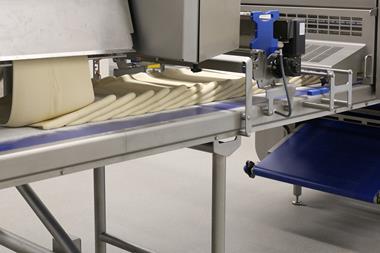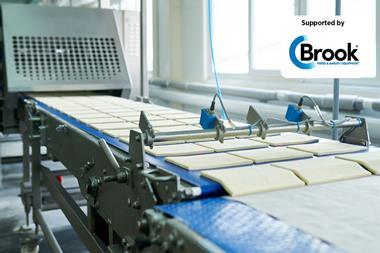Maintaining product quality and safety in a busy bakery can be problematic... and this is where the blast freezer can make a difference. But the technology is not suited to everyone
If Jeremy Clarkson shifted his attention from super cars to bakery refrigeration (sacrificing a fair chunk of his audience in the process), it’s likely blast freezing would catch his eye.
Sure, a Bugatti Veyron can do 0 to 60 in 2.5 seconds, but it’s not much use when you want to take a rack of bread from 70°C to between 0°C and 3°C in under 90 minutes – which is where blast freezing comes in.
For, although there a number of options for cooling baked goods to preserve them and maintain quality, a big difference between blast freezing and other methods is speed. It also keeps products a lot colder, at around -40°C rather than -20°C in a standard freezer.
Freezing baked goods very quickly creates smaller ice crystals, which helps preserve the quality of a product.
“Smaller ice crystals help maintain the structure of ingredients and the delicate texture of food, allowing prepared dishes to maintain their look, taste and national value,” says Steve Morris, sales director at Jestic Foodservice Equipment
This is a real benefit for bakery businesses. When producing delicate cakes, pastries and baked goods on a mass scale in a busy environment, the key lies in the consistency and quality of the offering. This can be a real obstacle when it comes peak periods.
Blast-freezing also helps guarantee food safety, says Simon Frost, director of sales and chain accounts at Hoshizaki UK, the manufacturer of Gram Refrigeration.
“Blast freezing has become one of the most common methods of ensuring food safety and enhanced storage in a bakery environment,” Frost says. “Not only does this process do this, but it also preserves the appearance, texture, flavour and nutritional value of food.”
Richard Ebbs, head of brands at Polar Refrigeration, points out that standard commercial refrigeration is designed for general purpose cold storage - not rapid cooling: “Blast freezers help reduce the amount of time food spends at the temperature at which pathogenic micro-organisms grow quickly and potentially become dangerous. Using standard refrigeration to chill hot food will simply raise the temperature of the appliance.”
In a bakery, products come out of the oven and are rolled into a blast freezer. Once frozen, they move to a holding freezer where they are kept at -18°C to -20°C.
“A blast freezer is a large engine in a small room,” says Patrick Tyrrell, technical director at CRS Cold Storage. “There is a large compressor and good air flow compared to a holding freezer, which has no temperature pull-down capability.”
Blast freezing is achieved through a forced airflow system, with cool air directed through the chamber and around its contents. A standard freezer does not use the same method and is used to store pre-frozen ingredients only.
It is important to use the equipment correctly, though, adds Tyrrell. “Some customers put plastic or cling film over the products, which acts like a lagging jacket, insulating the product from being frozen.
“Blast freezing is about circulating air around the product, so ideally all surface areas should be exposed. If you don’t have enough space, look at your loading arrangements,” he advises.
But blast freezing is not always the right option, warns Frost. “For delicate ambient items, to be served within a short period of time, a traditional refrigerator will provide the optimum storage facility and maintain the correct food temperature,” he says. “This is often the case for choux pastries and cakes containing fresh cream or dairy alternatives.”
But for many businesses, a blast freezer could be just the thing to help move production into top gear.
Cool options
Bakers seeking an alternative to conventional cooling and refrigeration systems, could consider vacuum cooling.
While this can reduce energy costs and takes up less space than conventional systems, some bakers have avoided it over concerns the process dries out certain products and removes flavour. But advances in vacuum pump design and more accurate control of the process means this no longer an issue, says Steve Merritt, managing director of EPP, which supplies and maintains vacuum cooling systems made by Swiss-based Aston Foods.
“It significantly improves the quality of the product by helping to maintain a better cell structure and lengthening the shelf life,” he says. “An unexpected benefit is that consumers report that the eating quality of gluten-free products is also substantially improved.”
Case study: Industrial chilling at Brook Street Foods
Chilled and frozen foodservice supplier Brook Street Foods has updated its transportation and storage facilities as part of continued development of its product range to meet customer needs.
Founded in 1990 and based in Needham Market near Ipswich, the business supplies a wide range of products including ambient and frozen bakery goods, across Norfolk, Suffolk and Essex. Its customers include schools, hospitals, hotels and restaurants, cafés and contract caterers.
Cold storage specialist CRS has worked with Brook Street for many years. Before its recent investment in new cold storage, Brook Street used a CRS Mega 40 cold storage solution that features barn doors to maximise storage capacity, and three independent refrigeration systems.
The supplier needed additional storage but had limited space on-site. With limited access and a tight schedule, engineers had to manoeuvre boxes into a tight area and then join them in the middle. With the limited space available, CRS built two CRS Mega 40s lengthways to give Brook Street a cold store measuring 24ft by 80ft with a side loading door.
This provided Brook Street Foods with the ability to freeze 80 pallets, which its staff can also get to with ease.





























No comments yet